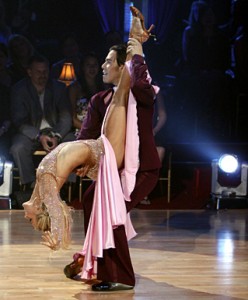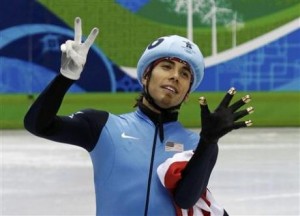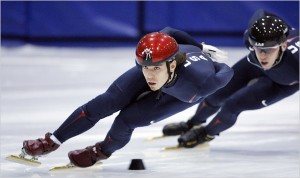7 Olympic Medals and Counting for Apolo Ohno
OK – I confess.

2007 Winners of Dancing with the Stars Apolo Ohno and Julianne Hough.
I watched Apolo Anton Ohno on Dancing with the Stars and fell in love with him as he moved that gorgeous blond Julianne Hough around the floor. He was, in a word, magnificent.
That radiant smile and generous persona lit up the airwaves. The man knows how to please and how to dance…
How does that translate into Olympic speed skating? Practically speaking, Ohno has become a cottage industry for the Olympics. He has drawn his Dancing with the Stars fans in droves into this exciting Olympic event. His charm and genuine good humor also endear him to speed skating fans and fellow athletes around the world.
Saturday night as he skated in the quarterfinals, semifinals and finals of the 1,000 meter short-track, it was difficult to watch, waiting for Ohno to do the seemingly impossible once again. He has made a habit of finding a way to medal in cliffhanger fashion.
Last night in the semifinals where he had to finish in the top two, his original move to pass on the outside was thwarted and Ohno found himself in trouble once again. But the wily American simply waited until there was a microscopic opening and darted past on the inside, securing second place and earning a spot in the finals.
I finally remembered to breathe as the replays began.
Did I fail to mention that Pacific Coliseum was packed. Yes, there were two Canadian brothers skating in the event, but the cheers for Ohno also rocked the place as he has become a focal point for advertisers and commentators at the Winter Olympics held in Vancouver in 2010.
In the finals Ohno almost suffered the agony of defeat. After making a daring move into second place with 2 1/2 laps to go, Ohno slipped, almost falling and found himself at the back of the pack in an instant.
The two Canadians, brothers Charles and Francois Hamelin, and the two Koreans, Le Jung-su and Lee Ho-suk, raced ahead of the American who had lost all of his acceleration in the debacle. With just one lap to go, Ohno summoned the strength to skate past the two Canadians and secure a bronze medal by a whisper. There was no time left to move on the two Koreans who took gold and silver.

Ohno celebrates capturing his 7th Olympic medal in Vancouver.
By winning that bronze medal, Ohno secured his 7th medal in winter olympic competition, surpassing the astounding Bonnie Blair who won her six medals in long-track speed skating.
Her last medals, both gold, in the 500-meter and 1,000-meter races she won in Lilliehammer in 1994.
16 years later, Ohno now owns the mantle for the number of medals won in winter olympics with seven –– and he has the opportunity to add even more.
Upcoming for Ohno are the 500-meter short-track race as well as the 5,000-meter relay where he will complete with other American speed skaters against the Canadians, Chinese and Koreans.
This means that Ohno has an opportunity to add even more to his medal count.
What is the difference, you ask, between long-track and short-track speed skating even though the distances covered are often the same, i.e, 500, 1000, 1500, 3000 and 5000 meters? This is the same question I asked myself because short-track speed skating reminds me somewhat of roller derby on ice, if the truth be known.
Short-track speed skating uses mass starts much like those used to begin marathon races. Such mass starts were often practiced in the United States and Canada but the more traditional skating and the two-man or two-woman starts continued to be practiced outside the North American continent.
Short-track speed skating is relatively new, incorporated into winter olympic events for the first time in 1992.
In contrast to long-track racing where skaters compete in pairs and in lanes on a 400 meter track, speed skaters in short-track have mass starts on a much shorter track and there are no lane requirements once the race gets underway.

Ohno demonstrates short-track quickness, speed and power.
There are bumps, jabs and aggressive tactics for all the participants which ultimately makes the race very exciting to watch. That may account for the sport’s new-found popularity with fans. It can be dangerous and difficult out there on the ice –– but that is also its lure.
It is into this chaotic, icy world that the young Ohno, with athletic talents and abilities beyond those of most mortal teenagers, decided to enter. With his father’s support, Ohno made it all the way to pinnacle of the sport.
Soon to be 28 years of age, it is doubtful that after the 2010 Olympics we will get to see Ohno compete again. So the message is –– if you haven’t already watched him skate, do so now because he has only two remaining events.
The 500 meter short-track speed skating competition begins on Friday February 26. Assuming Ohno reaches the finals of the 500-meter race and also that the American team reaches the finals of the 5,000-meter relay, Ohno could stand on the podium another two times.
It will be interesting to see how long Ohno’s record will stand –– perhaps another 16 years before the next great winter olympian surpasses the great Ohno.
I really sympathize with your perspective when it comes to this topic. Thanks for telling us about this. Are there any other posts like this one?
hrctamy
aybmcmap
Very Nice blog. Thanks for sharing this with us.
Having a inner blog is very beneficial for your website. It creates the brand of your website, and inform people all about your business.